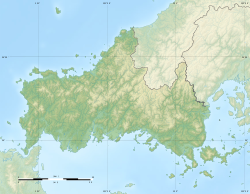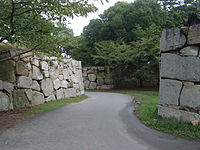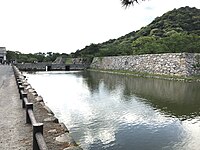Hagi Castle
Sites of Japan’s Meiji Industrial Revolution: Iron and Steel, Shipbuilding and Coal Mining | |
|---|---|
| Criteria | Cultural: (ii), (iv) |
| Reference | 1484-004 |
| Inscription | 2015 (39th Session) |
| Coordinates | 34°25′17″N 131°22′53″E / 34.421419°N 131.381389°E |
Hagi Castle (萩城, Hagi-jō) is a
Location

Hagi Castle is located at the seashore of Hagi city, in northeastern Yamaguchi Prefecture. The Hagi area borders the Sea of Japan and occupies the delta of the Abu River. The edge of the delta is Mount Shigetsu, with an elevation of 150 meters, which was formerly an island but is connected to the land by sandbank. The castle is built on Mount Shigetsu.
Like elsewhere in Japan, a town grew around the castle, and the area is now known as Hagi Castle Town.
Layout

Hagi Castle consisted of two square enclosures on Mount Shigetsu and the sandbank connecting it to the mainland. The ocean forms a natural moat on the back side of the castle and a water moat connected to the ocean protects the front. From the landward approach, these enclosures are at an angle, such that a corner of the enclosure faces the mainland to the southeast. Both areas are protected by stone walls and compound gates.
The tenshu (keep) was a five-story structure, and many yagura (turrets) were constructed at intervals on the stone walls. On the mainland was a tertiary area, also protected by moats, for the higher-ranked retainer's residences, and the castle town.
History
Founding

The site was originally occupied by a minor fortification erected by the Yoshimi clan, who were based at
After the death of Hideyoshi, the Mōri supported his son,
. However, the shogunate rejected these proposals and ordered that they build their stronghold at Hagi, which was at the time only a small fishing village, distant from important roads and was a swampy area hemmed in by hills and rivers. Construction of Hagi Castle began in 1604 and was completed in 1608.Although
Destruction and ruins
In 1874, most of the castle structures were demolished by order of the new
It was registered as a
-
Remaining walls
-
The inner moat
-
The outer moat
See also
- List of Historic Sites of Japan (Yamaguchi)
- Sites of Japan’s Meiji Industrial Revolution: Iron and Steel, Shipbuilding and Coal Mining
References
- ^ "萩城跡" (in Japanese). Agency for Cultural Affairs.
- ^ "Sites of Japan's Meiji Industrial Revolution: Iron and Steel, Shipbuilding and Coal Mining". UNESCO. Retrieved 21 October 2015.
- ^ "Hagi Castle". Archived from the original on 2008-03-13. Retrieved 2008-04-17.
- ^ "萩城城下町" (in Japanese). Agency for Cultural Affairs.
- ^ "指月山" (in Japanese). Agency for Cultural Affairs.
- ^ Japan Castle Foundation
- ^ "Hagi Castle Town". Archived from the original on 2013-10-16. Retrieved 2012-02-17.
- ^ "Sites of Japan's Meiji Industrial Revolution: Iron and Steel, Shipbuilding and Coal Mining".
Literature
- De Lange, William (2021). An Encyclopedia of Japanese Castles. Groningen: Toyo Press. pp. 600 pages. ISBN 978-9492722300.
- Schmorleitz, Morton S. (1974). Castles in Japan. Tokyo: Charles E. Tuttle Co. pp. 144–145. ISBN 0-8048-1102-4.
- Motoo, Hinago (1986). Japanese Castles. Tokyo: Kodansha. p. 200 pages. ISBN 0-87011-766-1.
- Mitchelhill, Jennifer (2004). Castles of the Samurai: Power and Beauty. Tokyo: Kodansha. p. 112 pages. ISBN 4-7700-2954-3.
- Turnbull, Stephen (2003). Japanese Castles 1540-1640. Osprey Publishing. p. 64 pages. ISBN 1-84176-429-9.








